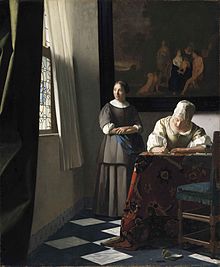| Writing to Vermeer | |
|---|---|
| Opera by Louis Andriessen | |

Lady Writing a Letter with her Maid, one of several paintings by
Vermeer which inspired the opera's libretto | |
| Librettist | Peter Greenaway |
| Language | English |
| Premiere | 1 December 1999 |
Writing to Vermeer is an opera in six scenes composed by Louis Andriessen with incidental electronic music by Michel van der Aa. The English-language libretto, inspired by the paintings of Johannes Vermeer, was written by Peter Greenaway. Saskia Boddeke directed the premiere production at the Dutch National Opera on 1 December 1999. [1]
Background and performance history
Writing to Vermeer was Andriessen's third collaboration with British film director and screenwriter Peter Greenaway. Set in the Delft household of the Dutch painter Johannes Vermeer in May 1672, Writing to Vermeer is composed for three women singers (two sopranos and a mezzo-soprano) each of whom writes six letters to Vermeer in his absence. Several of Vermeer's paintings portray women writing or reading letters, including Lady Writing a Letter with her Maid, The Love Letter, and A Lady Writing a Letter. Andriessen said of his decision to accept Greenaway's proposal for the libretto: "I feel very close to the attitude of the painter [Vermeer] who fixes on his canvas brief 'stolen' moments that are eternally beautiful." [2] [3]
Although the story is imaginary, two of the characters, Vermeer's wife Catherine Bolnes and her mother Maria Thins, are real historical figures. The third, his model Saskia, is fictional. The chosen year for the setting, 1672, is known as the "Disaster Year" of Dutch history when the country suffered military defeats and serious civil unrest with large parts of the country deliberately flooded to prevent the advancement of the French troops. As Bernard Holland observed, the cataclysmic events outside the walls of Vermeer's house serve as the backdrop against which the women's letters about everyday domestic life and Vermeer's own quiet paintings of interiors are contrasted. However, the opera's tragic ending reflects the final intrusion of chaos from the world outside, chaos which ultimately ruined Vermeer's life. [2] [4]
The Greenaway/Boddeke production includes ten film "inserts" by Boddeke which depict the violence going on outside the house and are projected on a screen behind the singers. The cast of singers is augmented by dancers depicting the female subjects in Vermeer's paintings such as The Milkmaid. They occasionally "freeze" in the same pose depicted in the painting. The production travelled to Australia in March 2000 for the Adelaide Festival and then to New York City in July of that year for its US premiere at the New York State Theater. [2] [4] [5] In 2004 Writing to Vermeer was revived by the Dutch National Opera and a studio recording with the original cast was made for the Nonesuch label. [6]
Roles
| Role | Voice type [5] | Premiere cast, 1 December 1999
[2] (Conductor: Reinbert de Leeuw) |
|---|---|---|
| Catherine Bolnes, Vermeer's wife | soprano | Susan Narucki |
| Maria Thins, Vermeer's mother-in-law | mezzo-soprano | Susan Bickley |
| Saskia de Vries, Vermeer's model | soprano | Barbara Hannigan |
| Two of Vermeer's children, chorus of women | ||
Recordings
- Andriessen: Writing to Vermeer – Susan Narucki, Susan Bickley, Barbara Hannigan; Dutch National Opera and the ASKO and Schoenberg Ensemble conducted by Reinbert de Leeuw. Label: Nonesuch Records [7]
See also
References
- ^ Boosey & Hawkes. Andriessen, Louis: Writing to Vermeer (1997–98)
- ^ a b c d Trochimczyk, Maja (2002). "Writing to Vermeer: A View of a 'Filmic' Opera" in Maja Trochimczyk (ed.). Music of Louis Andriessen, pp. 259–276. Routledge. ISBN 1-136-76965-X
- ^ Toop, David (2010). Sinister Resonance: The Mediumship of the Listener, p. 100. The Continuum. ISBN 1-4411-4972-4
- ^ a b Holland, Bernard (13 July 2000). "The Chaos Outside Vermeer's Quiet Rooms". The New York Times. Retrieved 23 January 2017.
- ^ a b Potter, Keith and Gann, Kyle (eds.) (2016). The Ashgate Research Companion to Minimalist and Postminimalist Music, p. 138. Routledge. ISBN 1-317-04255-7
- ^ Clements, Andrew (2006). Andriessen: Writing to Vermeer. BBC Music Magazine. Retrieved 23 January 2017.
- ^ Hunter, James (14 May 2006). "'Writing to Vermeer': An Epistolary Tour de Force". The Washington Post. Retrieved 23 January 2017.